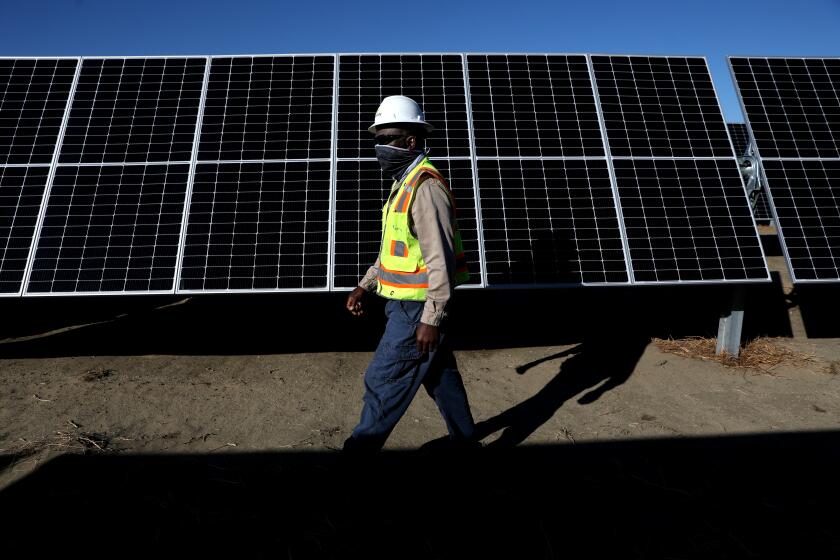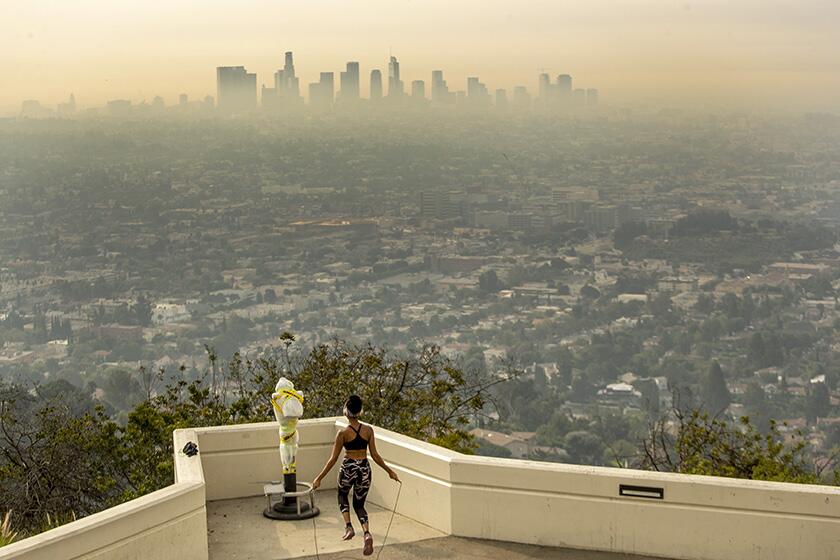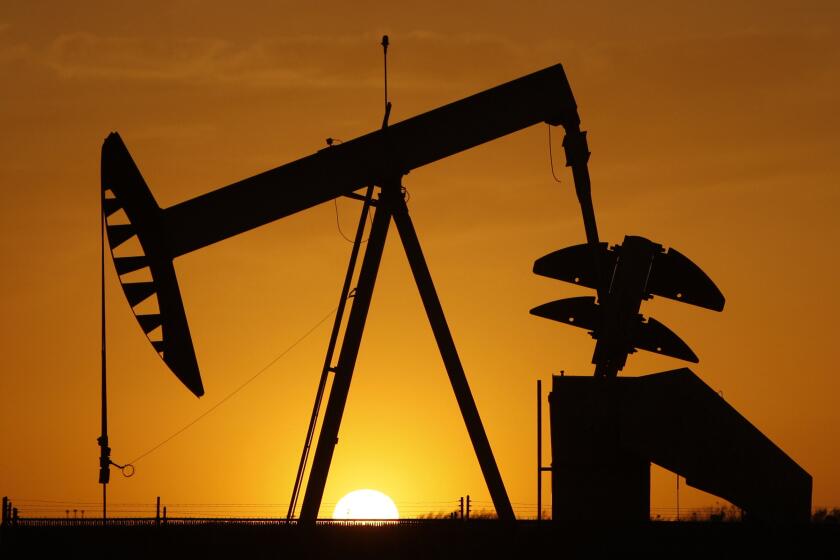Drought, heat waves could worsen air pollution for vulnerable communities

- Share via
Within just a few years, California endured its driest three-year period on record and its hottest September in history — a brutal summer month that nearly broke the state’s overtaxed electric grid.
Now, new research suggests that the hardships inflicted by those events may be more widespread than previously thought. Drought and extreme heat also worsened air pollution for low-income and non-white communities throughout California, researchers say, further degrading health in neighborhoods that have long struggled with environmental inequities.
When electricity demands skyrocket during extreme heat waves and drought reduces water availability for hydropower production, power systems depend more on fossil fuels to meet energy needs and avoid rolling blackouts. The result is an increase in emissions of greenhouse gasses, sulfur dioxide, fine particulate matter and nitrogen oxides, study authors say.
“Under normal circumstances, people of color are more exposed to air pollution from power plants because they’re predominantly located in counties that have higher percentages of people of color living in them, and that just gets worse when there are droughts and heat waves,” said Jordan Kern, assistant professor of forestry and environmental resources at North Carolina State University and a study co-author.
Fitting together the puzzle pieces will require doing things that seem politically impossible today.
Air pollution is one of the greatest environmental threats to health, and the combined effects of outdoor air pollution and household air pollution are associated with 6.7 million premature deaths annually, according to the World Health Organization.
In the case of California residents, increased air pollution associated with drought was determined to last for months or even years, whereas researchers found that heat waves created brief spikes in emissions.
Led by North Carolina State University, the study also found that fining power plants could reduce their emissions and people’s exposure to pollutants, except during heat waves, when system operators are forced to deploy more fossil fuel power plants to avoid power shutoffs.
“The ineffectiveness of penalties tends to happen late summer, early fall — that’s kind of what California went through in September, where you don’t really have any hydropower to produce because the snow melt season is over,” Kern said.
Read all of our coverage about how California is neglecting the climate threat posed by extreme heat.
Last September, a heat wave shattered temperature records in the state and wreaked havoc on the electric grid and other infrastructure. To meet power demands and avoid power outages, Gov. Gavin Newsom issued a series of proclamations allowing, among other things, generators fueled by natural gas to run without restrictions.
Ari Eisenstadt, campaign manager for Regenerate California, a campaign aimed at ending fossil fuel use in the state, said that when the power grid is overtaxed, the first communities to experience blackouts are often the same ones where gas plants are located. And where that energy goes is not always known.
“There are many front-line communities where it’s much less likely that they’ll have access to home cooling, and so the demand isn’t necessarily coming from the communities themselves where those plants are being turned on,” said Eisenstadt, who was not involved in the study. “We have a tendency as a state and as a country to really outsource pollution based on needs that are occurring elsewhere.”
Using a simulation tool, the study’s researchers calculated how much sulfur dioxide, nitrogen oxides and fine particles power plants in California could emit across 500 “synthetic weather years.” These years imitated conditions that could happen in the future based on historical air, wind, temperature and solar radiation records between 1953 and 2008 on the West Coast. They estimated air pollution across counties by identifying locations of power plants and assessing how much electricity they would generate under different weather conditions.
The study did not consider the long-term impacts of climate change however, although researchers acknowledged global warming’s contribution to worsening cycles of drought and extreme heat events.
Southern California has long struggled to meet federal air pollution standards. Now, the EPA wants to impose even higher requirements for particulate matter.
While sulfur dioxide is less of a problem in the Northwest than in the Midwest, which burns more coal, people with asthma are particularly sensitive to it, said Ed Avol, professor emeritus at USC Keck School of Medicine, who was not involved in the study.
Nitrogen oxides and fine particles are bigger issues in California, he said. When inhaled at low levels, nitrogen oxides, the precursor to smog, can irritate the eyes, throat and lungs, and cause nausea or shortness of breath. At higher levels, they can lead to inflammation in the throat and upper respiratory tract; the buildup of fluid in the lungs, and even death.
In the short term, inhaling fine particulate matter has been linked with premature mortality, bronchitis and other health problems in people with preexisting heart or lung diseases. Long-term exposure has been associated with stymied lung growth in children.
Low-income and communities of color often experience “a triple or quadruple whammy” of “disproportionate exposures,” Avol said. They tend to live closer to freeways, trucking centers, refineries and other industrial locations that increase their exposure to toxins, and may not have adequate healthcare access if they do fall ill. “All these different factors that potentially increase your exposure are all tilted unfairly in their direction so that they get more than somebody else.”
Officials at the ports of Los Angeles and Long Beach recorded an unprecedented surge in harmful emissions during 2021. They blame COVID-19.
While California has adapted ambitious climate policies to cut greenhouse gas emissions, wildfires and heat waves are complicating those efforts. Yet if the state wants to meet carbon neutrality by 2045, experts agree it will need to get all of its electricity from non-carbon or renewable sources.
The net result of clean energy would lower everyone’s exposure to air pollution, especially fine particles, said Michael Kleeman, professor in civil and environmental engineering at UC Davis who was not involved in the study, but researches how regional and urban air pollution affect public health.
His research has found that adopting low-carbon energy sources makes air pollution exposure more equitable across communities. But you can’t erase the disparity entirely, he said. “Some of it is just locked in because of red lining and other past housing practices, but you can reduce it.”
Study finds that minority neighborhoods where residents were long denied mortgages have twice as many oil and gas wells as mostly white neighborhoods.
For now, the study’s authors said the state can protect people from the combined consequences of heat waves and air pollution in several ways, such as instituting programs that compensate consumers for decreasing electricity use, and urging power systems to avoid initiating rolling blackouts in vulnerable communities at times of day when people would be exposed to high levels of air pollution if they went outside.
And during hot days when electricity demand is high, it will be important to consider how cooling centers will be powered and where they are located, “especially moving forward under climate change,” Kern said.
“I think that’s the obvious next step,” Kern said. “How much worse is this going to get when you factor climate change, but also how much better can this problem get if you really quickly decarbonize the grid?”
More to Read
Sign up for Essential California
The most important California stories and recommendations in your inbox every morning.
You may occasionally receive promotional content from the Los Angeles Times.
















